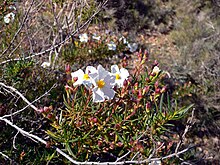Cistus clusii
| Cistus clusii | |
|---|---|

| |
| Scientific classification | |
| Kingdom: | Plantae |
| Clade: | Tracheophytes |
| Clade: | Angiosperms |
| Clade: | Eudicots |
| Clade: | Rosids |
| Order: | Malvales |
| Family: | Cistaceae |
| Genus: | Cistus |
| Species: | C. clusii |
| Binomial name | |
| Cistus clusii Dunal[1] | |
| Synonyms[1] | |
| |
Cistus clusii is a shrubby species of flowering plant in the family Cistaceae, with white flowers, native to south west and south central Europe and north Africa. It has been wrongly called Cistus libanotis by many authors.
Description
Cistus clusii is a much branched shrub, up to 1 m (3 ft) tall. Its leaves are narrowly linear in shape, usually 1–2.5 cm (0.4–1.0 in) long by 1–2 mm (0.04–0.08 in) wide, with edges that are turned under (revolute), green on the upper side and densely covered with short hairs on the lower side, producing a whitish appearance. The flowers are arranged in umbel-like cymes with up to 12 individual flowers, each 2–3 cm (0.8–1.2 in) across with five white petals and three sepals, 5–8 mm (0.2–0.3 in) long. The flower stalks (peduncles and pedicels) and the sepals are covered with long white hairs. The style is short.[2]
Taxonomy
Cistus clusii was first described by Michel Félix Dunal in 1824.[1][3] The specific epithet clusii honours Carolus Clusius. The name Cistus libanotis has been wrongly applied to this species by many authors.[2] A 2011 molecular phylogenetic study placed C. clusii in a clade with Cistus munbyi in the white and whitish pink clade of Cistus species, sister to all the remaining white and whitish pink flowered species.[4]
Phylogeny
Cistus clusii belongs to the white and whitish pink flowered clade of Cistus species.
| Species-level cladogram of Cistus species. | ||||||||||||||
| ||||||||||||||
| Species-level cladogram of Cistus species, based on plastid and nuclear DNA sequences.[5][6][7][4] |
Distribution
Cistus clusii is native to north Africa[7] and the west and central Mediterranean region: southern Spain, the Balearic Islands, south-east Italy and Sicily.[2]
References
- ^ a b c "Cistus clusii", The Plant List, retrieved 2015-03-02
- ^ a b c d Warburg, E.F. (1968), "Cistus clusii", in Tutin, T.G.; Heywood, V.H.; Burges, N.A.; Valentine, D.H.; Walters, S.M. & Webb, D.A. (eds.), Flora Europaea, Volume 2: Rosaceae to Umbelliferae, Cambridge University Press, p. 284, ISBN 978-0-521-06662-4
- ^ Dunal, M.F. (1824), "28. C. clusii (Cistineae)", in de Candolle, A.P. (ed.), Prodromus systematis naturalis regni vegetablis, p. 266, retrieved 2015-03-06
- ^ a b Civeyrel, Laure; Leclercq, Julie; Demoly, Jean-Pierre; Agnan, Yannick; Quèbre, Nicolas; Pélissier, Céline & Otto, Thierry (2011), "Molecular systematics, character evolution, and pollen morphology of Cistus and Halimium (Cistaceae)", Plant Systematics and Evolution, 295 (1–4): 23–54, doi:10.1007/s00606-011-0458-7, S2CID 21995828
- ^ Guzmán, B. & Vargas, P. (2005). "Systematics, character evolution, and biogeography of Cistus L. (Cistaceae) based on ITS, trnL-trnF, and matK sequences". Molecular Phylogenetics and Evolution. 37 (3): 644–660. doi:10.1016/j.ympev.2005.04.026. PMID 16055353.
- ^ Guzmán, B. & Vargas, P. (2009). "Historical biogeography and character evolution of Cistaceae (Malvales) based on analysis of plastid rbcL and trnL-trnF sequences". Organisms Diversity & Evolution. 9 (2): 83–99. doi:10.1016/j.ode.2009.01.001.
- ^ a b Guzman, B.; Lledo, M.D. & Vargas, P. (2009), "Adaptive Radiation in Mediterranean Cistus (Cistaceae)", PLOS ONE, 4 (7): e6362, Bibcode:2009PLoSO...4.6362G, doi:10.1371/journal.pone.0006362, PMC 2719431, PMID 19668338
External links
- Page, R.G. (n.d.) [2002 onwards], "Cistus clusii L.", The Cistus & Halimium Website, archived from the original on 2015-04-02, retrieved 2015-03-09
